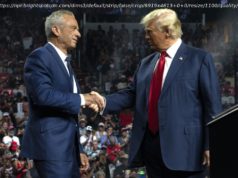« Volatile » but not « a powder keg »: An expert explains the state of play in a tense Asia-Pacific region.
The saga of the Chinese spy balloon floating over the United States dominated media attention last week, and its destruction by the US seemed a signal moment in the relationship between the two superpowers.
It had already been a tense few months. Just before the balloon standoff, Washington took a major step to expand its military presence around the Chinese mainland. The US and the Philippines announced a deal allowing the American military to use four more bases in the Philippines. It was the latest move by Washington to build up its defensive position in the Asia-Pacific, the likeliest site of any confrontation between the two.
The agreement with the Philippines followed last month’s announcement by the US and Japan that they were adjusting the American troop presence on Okinawa along with several other defense measures, as the countries’ top diplomats and military officials condemned Beijing’s aggressiveness in the South China Sea.
And in September 2021, Washington agreed to provide Australia with nuclear-powered submarines as part of a new AUKUS defense alliance that includes Australia, the UK, and the US. The security partnership also includes cooperation in cybersecurity, artificial intelligence, and quantum computing.
Meanwhile, Taiwan, which China claims as part of its historic territory, remains the biggest point of contention between the two countries. Then-House Speaker Nancy’s Pelosi’s visit there last summer caused weeks of hostile rhetoric and unprecedented defense maneuvers by Beijing near the island, and the People’s Republic has markedly increased its military flights around Taiwan in recent years.
So just how dangerous is the situation in the Asia-Pacific becoming? To find out, I spoke with Jeremy Mark, a senior fellow in the GeoEconomics Center of the Atlantic Council, a Washington-based think tank. Mark was previously a journalist for CNBC Asia and the Wall Street Journal, and he has lived in Singapore, Taiwan, and Japan. A transcript of our conversation follows, edited for length and clarity.Michael Bluhm
How volatile is the situation in the Asia-Pacific? Jeremy Mark
The situation is quite volatile, but I don’t think it’s a powder keg.
Over the last decade, in particular, China has taken actions that have created volatility unaccustomed in the region since the Vietnam War. China has bullied and intimidated Japan, South Korea, Taiwan, and the Philippines. At its land border with India, China’s provocations in the last two years have resulted in soldiers losing their lives. All this points to a significant escalation of tensions.
That said, I don’t think there is a looming regional or US-China conflict. Trade and business are proceeding. The integration of supply chains among China and its trade partners remains very deep.
China is profoundly preoccupied with its own economy at the moment because of the impact of Covid, a severe real-estate slump, high youth unemployment, and several other issues. This is not a country that’s about to endanger its future by launching a war.Michael Bluhm
What are the possible consequences of the Philippine bases for regional security? Jeremy Mark
The US sees the consequences positively. There has essentially been a hole in the US regional defense against China — one which is now being filled by this agreement.
It’s also a message to China that its provocative actions have resulted in the Philippines returning to the pro-American place that it once had in regional security arrangements.
But from China’s point of view, this increases volatility. The presence of US troops in the north of the Philippines’ Luzon island — the closest island to Taiwan — may introduce more tension into some situations.
Michael Bluhm
This agreement is only the latest in a series of new defense ties with countries in the region, such as the recent deal with Japan and the AUKUS submarine deal.






